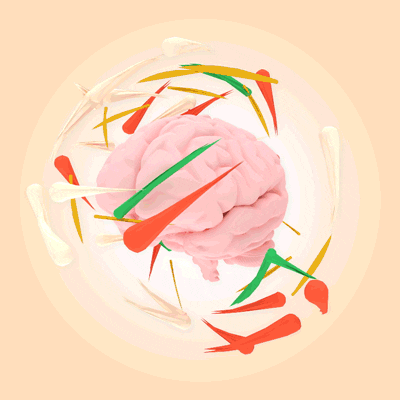
Your brain: it’s a complicated, beautiful mess. Scientists have been trying to break the enigma since the 17th century. While we still have a long way to go before a solid mastery of the brain, we’ve learned some tried and true facts about the way our brains work, and how we learn.
John Medina, developmental molecular biologist, wrote a book consolidating years of research and studies into 12 principles about our brain. For the sake of brevity, we won’t dive deep into the nitty-gritty of the science. However, we will highlight 3 “brain rules” and how we can apply those in an office setting.
We recommend his book for its broad appeal to virtually any life situation.
The 3 principles we’ll focus on are:
- Wiring
- Attention
- Memory
Let’s get right into each principle.
Wiring
Main concept: Everyone’s brain is wired differently.
If everyone’s brain is wired differently, how do we know that the Occipital lobe interprets vision, or that the Parietal lobe interprets language and words?
Think of it this way: the brain is like a giant system of roads. Everyone has the same highway system; our main roads are the same. As soon as you move to the smaller, more local roads, the system changes from person to person. Not even identical twins have the same pathways.
How does this happen? Every time we experience or learn something, our neurons are physically altered. Your experience in life changes the way your brain is structured.
Here’s an example of how experience can change the way you view an event.
Let’s say you and your friend, Joe, go to the new Star Wars movie. You’re an avid Star Wars fan. Joe hasn’t even seen the original trilogy. You’ll understand the importance of certain plot points while Joe may be lost – all because of your previous experience.

That same concept of experience-reliant learning is true in an office setting. Seemingly unrelated experiences can alter the way you learn new Excel concepts, for example.
Medina suggests throwing mass-education out the window. Smaller, personalized, and targeted learning is a much more efficient form of training. Customize your trainings to help employees perform better. An advanced PowerBI course may be great for Stephanie, but it might not fit for Brandon, even if they both work with data.
Takeaways: Everyone learns and processes information in a unique way due to the experience they’ve acquired throughout their life.
- Segment your users into smaller and more personalized groups. Then segment again.
- Don’t assume your users will learn everything at the same pace. Some users will take longer than others to fully grasp a concept.
Note: BrainStorm allows you to provide scalable, targeted training to specific segmented groups.
Attention
Main concept: We learn better when we pay attention.
Our attention is a limited resource. Studies and anecdotal evidence have suggested time and time again that our brains have a 10-minute cap. Why? No one knows. But this pattern is consistent and offers another insight about how we learn: we have a fairly short attention span.
So how does a 2-hour movie hold our attention? Well, it is possible to “reset” that 10-minute timer. The answer lies in how the brain pays attention.
First, emotion.
An emotionally charged event is more memorable than a neutral one. The amygdala will essentially put a giant Post-It note on the memory saying: “Remember this!”
Second, organization of information.
The difference between a novice and a master teacher, according to Medina, is not the level of knowledge they have about a subject, but how they organize the information they teach.
How do expert teachers organize their information? They use a top-down approach. They present the big picture first. You must understand the meaning and the gist of a concept before you’re able to pay attention to the details.
In fact, when information is organized and delivered in this top-down hierarchy, we remember 40% better.
Third, multitasking.
It’s impossible for your brain to multitask. In fact, by shifting your focus and attention back and forth, your task will take 50% longer with up to 50% more errors.

Takeaways: The organization of information makes a huge impact on whether we pay attention and how well we remember the information.
- Add emotion to training – strategically place jokes or short stories about every 10 minutes to refresh attention.
- Keep your presentations short and sweet – highlight the main idea in the first minute and expand from there. Follow this template for each concept you want to cover.
- Do one thing at a time. Give users a distraction-free zone by turning on Do Not Disturb mode in Teams.
Memory
Main concept: Repetition is key.
As frustrating as it can be, forgetting plays an essential role in our survival and functionality. It helps us prioritize. So, how do we prioritize the pieces of information we don’t want to forget?

There are a few tricks to try.
The first is to add meaning to information you’re learning. If you’re learning about how to Flash Fill in Excel and you recognize that it could have been used to save you time yesterday, you’re more likely to remember how to use it.
The second is to use real-world examples. This gives the brain a “shortcut” into your memory by grouping the new information with previously stored information.
The third is to replicate the conditions you were in when you initially learned a concept. This could be anything from being in the same physical location, listening to the same music, or even chewing the same flavor of gum. This also lends itself to the idea of delivering training in the same location the information will be used (like at your desk).
These strategies can help, but at the end of the day, you’ll forget 90% of what you learn in a classroom setting within 30 days of learning it. Most of the forgetting happens in the first few hours.
Repetition is key, but so is timing. Repeating information back-to-back improves memory, but to really solidify what you want to learn, repeat the information in spaced intervals.
Training is never one-and-done. It’s an ongoing process. In fact, it can take years for information to be stored in long-term memory.
Takeaways: Learning in short, repeated segments is the ideal way to remember information.
- Give employees access to regular intervals of training, especially new employees.
- Deliver training in contextual circumstances to give users a leg-up on remembering the information.
Note: BrainStorm gives users access to contextual training at regular intervals.
Neuroscience is a fascinating subject, and one that integrates seamlessly with change management. To learn more about how your company can improve training and adoption for your users, schedule a demo.


